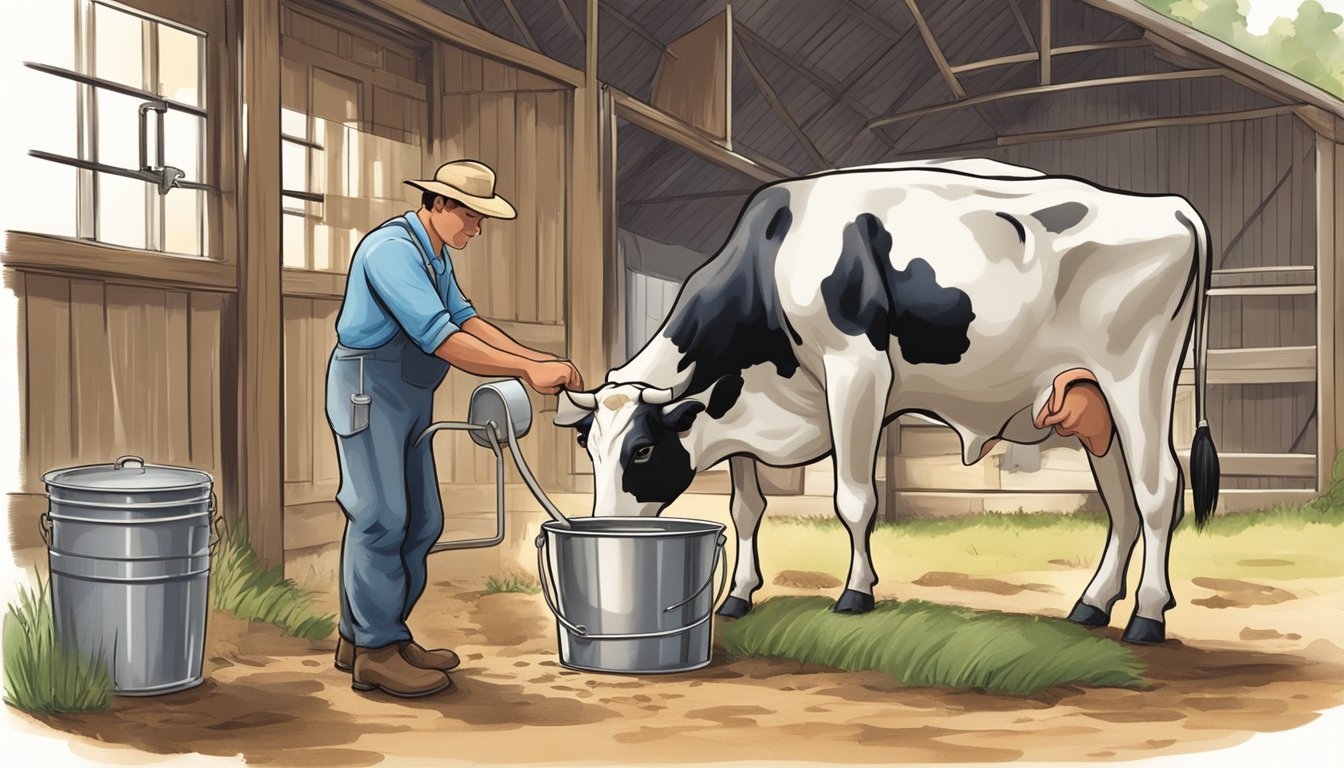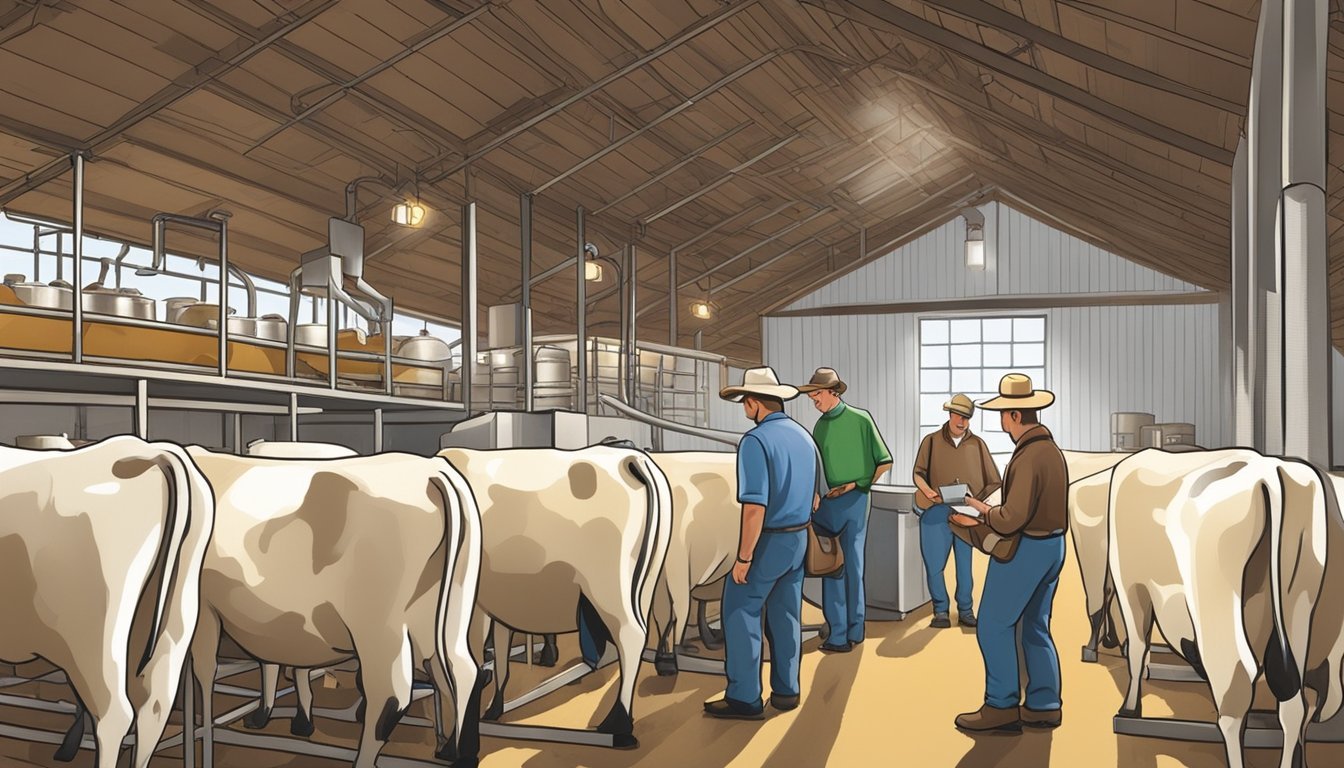Creating a Safe Raw Milk Practice
Essential Guidelines for Farmers
Raw milk, the unprocessed milk straight from the cow, has its enthusiasts who appreciate its natural flavors and nutritional benefits. However, producing and handling raw milk safely is crucial because it can harbor dangerous pathogens if not managed properly. Farmers have a responsibility to maintain high hygiene standards and a well-structured Risk Analysis and Management Plan (RAMP) to ensure the safety of their product. By adhering to strict practices, they can ensure their raw milk maintains a low count of coliforms per milliliter, a key indicator of cleanliness and safety.
The Raw Milk Institute provides guidance and support to farmers through training and a listing program that encourages adherence to common standards. These standards are designed to keep raw milk free from pathogens. Proper milking hygiene, such as clean milking practices and secure storage, play pivotal roles in safeguarding the quality of raw milk. Farmers invest in on-farm lab testing equipment to monitor the milk regularly, ensuring that safety targets are consistently met.
For consumers, the freshness and proper handling of raw milk are indicative of its quality. Milk with a longer shelf life without signs of spoilage, such as rising bubbles from coliform bacteria, is usually the result of good farm practices. By following these guidelines, farmers contribute to producing raw milk that is as safe as it is nourishing, thereby upholding both the tradition and the trust placed in this natural product.
Creating a safe raw milk practice involves understanding the principles of raw milk safety science to ensure that consumers can enjoy raw milk products with confidence. Embracing raw milk homesteading involves implementing safe and sustainable practices to support local, small-scale dairy production, fostering a closer connection between producers and consumers.
Exploring the process of lacto-fermentation raw milk can be a part of creating a safe raw milk practice, as it offers a way to preserve raw milk naturally while promoting the growth of beneficial bacteria. Understanding the raw milk microbiome and its potential impact on gut health is crucial in creating safe raw milk practices, as it provides insights into the natural components of raw milk and their potential benefits.
Addressing concerns related to lactose sensitivity raw milk involves creating safe practices that cater to individuals with lactose intolerance, potentially offering options for those seeking dairy products that align with their dietary needs. By incorporating these considerations and emphasizing safe production and handling practices, creating a safe raw milk practice can provide consumers with access to high-quality raw milk products while promoting responsible and sustainable dairy practices.
Understanding Raw Milk
Raw milk refers to milk from cows, goats, sheep, or other animals that has not been pasteurized to kill harmful bacteria. This natural state of milk can contain a wide range of nutrients, including vitamins, minerals, enzymes, and beneficial bacteria.
Consumers often seek out raw milk for its nutritional qualities, believing it to be more wholesome and closer to its natural state. However, it also carries a risk of containing foodborne pathogens that can cause illness, which makes it controversial.
On dairy farms, maintaining the health of the animals is crucial for producing safe raw milk. Healthy animals are less likely to harbor pathogens that can contaminate milk. Producers adopt rigorous sanitation practices and regular health screenings to minimize risks.
Here's a brief overview of practices typically found on farms to ensure the safety of raw milk:
Hygiene: Ensuring the cleanliness of cows and the environment through regular bathing and barn cleaning.
Milking protocol: Utilizing clean techniques for milking, such as pre-dipping and single-use rags to prevent cross-contamination.
Cold storage: Quickly cooling milk after milking to inhibit bacterial growth.
Regular testing: Conducting tests for pathogens, somatic cell counts, and bacteria levels to assess milk safety.
Education: Farmer education programs, like those provided by the Raw Milk Institute, promote standards and testing for safer raw milk production.
While raw milk can be a nutritious product, it requires diligent management to ensure it is produced safely. It represents a potential niche for farmers with a commitment to transparency and health.
Health Benefits and Risks
Consuming raw milk comes with potential health benefits and several risks that consumers need to be aware of. The Raw Milk Institute emphasizes strict hygiene and safety protocols among producers to minimize these risks.
Health Benefits:
Allergies & Asthma: There is evidence suggesting that raw milk consumption may be linked to a reduced incidence of allergies, asthma, and eczema, particularly in children.
Respiratory Infections & Fever: Studies indicate that early life consumption might lower the risk of respiratory infections and fevers.
Risk Analysis:
While raw milk proponents highlight benefits, it's important to consider the following risks:
Bacterial Contamination: Raw milk can harbor harmful bacteria such as E. coli, Salmonella, Listeria, and Campylobacter, leading to foodborne illnesses.
Brucellosis & Tuberculosis: Illnesses like brucellosis and tuberculosis can also be transmitted through contaminated raw milk.
To reduce the risks, the Raw Milk Institute advocates for:
Rigorous farm management practices
Regular testing of milk for pathogens
Complete transparency for consumers
Educational efforts on proper handling and storage of raw milk
Safety Recommendations:
Hygiene: High levels of cleanliness during milking, storing, and bottling.
Cold Storage: Keeping raw milk at appropriate temperatures to slow bacterial growth.
Transparency: Clear labeling and provision of information about the milk's origin and handling.
Best Practices for Raw Milk Production
The key to safe raw milk production lies in stringent practices focused on animal health, impeccable hygiene, and precise milking and storage protocols. Ensuring the well-being of the animals, preventing contamination at every step, and keeping the milk at safe temperatures are essential to achieving high-quality raw milk.
Animal Health and Welfare
The foundation of raw milk safety begins with maintaining high standards of herd health and animal welfare. This includes regular health checks by veterinarians to prevent diseases that could compromise milk quality. Farmers should employ:
Regular vaccinations and parasite control programs.
Appropriate nutrition and housing that promote good health.
Hygiene and Sanitation
Hygiene plays a pivotal role in preventing pathogens and contamination. Cleanliness in the farm environment, especially where milking occurs, is critical. The farm must implement:
Standard Operating Procedures (SOPs) for cleaning milking systems and the environment.
Testing routines for water, equipment, and milk to monitor for contaminants.
Pre- and post-milking teat dips to reduce microbial load.
Milking and Storage
The milking process and subsequent storage must prioritize biosecurity and milking hygiene. To maintain the cold chain and ensure milk freshness, the following methods should be adhered to:
Refrigerate raw milk immediately after milking at 4°C (39.2°F) or below.
Use sanitized equipment and bulk tanks to prevent any introduction of bacteria.
By following these practices with diligence, producers can offer raw milk that adheres to safety standards, keeping consumers' health in the forefront.
Regulatory Compliance and Safety Standards
Ensuring that dairy farmers align with regulatory compliance and safety standards is crucial for both public health and the viability of a farm's raw milk production.
Understanding Regulations
Regulatory compliance for raw milk production varies significantly from one region to another, but the underlying principles focus on ensuring the safety of dairy products for consumers. Guidelines typically specify standards for bacterial test thresholds such as for coliforms and Standard Plate Count (SPC) to prevent foodborne illnesses. Dairy farmers must be thoroughly informed about their local regulations to maintain a legal operation. Food safety is a paramount concern, as unpasteurized dairy products have been associated with health risks if not properly managed.
Role of the Raw Milk Institute
The Raw Milk Institute (RAWMI) plays a pivotal role in promoting safe food practices among producers of raw milk. With its mission to lower the risk of foodborne illness, RAWMI provides training and mentoring to farmers. Their RAWMI Common Standards offer a framework for producing safe raw milk, integrating:
Farmer training and mentoring, which equips producers with needed knowledge and techniques.
A Risk Analysis and Management Plan (RAMP) tailored to each farm to address unique conditions.
Standard Plate Count (SPC) and coliform thresholds to ensure milk safety.
RAWMI acts as an educational and standard-setting entity aiming to bridge the gap between dairy farmers and regulatory compliance concerns, thereby fostering a safer raw milk market.
Monitoring and Testing for Pathogens
Monitoring and testing for pathogens are crucial steps in ensuring the safety of raw milk. Employing consistent testing practices helps in detecting potential contamination early, mitigating the risks of illness outbreaks, and maintaining public health.
Pathogen Detection
Farmers should conduct regular pathogen tests to detect harmful microorganisms such as E. coli, Salmonella, Listeria monocytogenes, and Campylobacter spp. which can cause severe illnesses. Testing typically includes:
Somatic cell count (SCC): Provides an indication of milk quality, where a high SCC may suggest an infection in the milking herd.
Coliform count: Serves as an indicator of sanitation and milk handling practices; high coliform counts can signal the presence of harmful bacteria.
Standard Plate Count (SPC): Measures the number of aerobic bacteria and aids in assessing raw milk's overall microbial quality.
To conduct these tests, farmers may set up small on-farm labs with incubators, which usually cost between $800-$1,000. Grants may be available to offset these costs, encouraging farmers to adopt such safety measures.
Interpreting Test Results
Interpreting test results effectively is key to determining the presence of pathogens and assessing the potential risk to consumers. Farmers must understand:
Test Sensitivity and Specificity: They must select tests that accurately identify specific pathogens without cross-reacting with non-harmful bacteria.
Regulatory Standards: Familiarity with local and national safety standards allows farmers to recognize when milk approaches or exceeds thresholds requiring action, such as a recall.
Indicator Bacteria Levels: Elevated levels of indicator bacteria like coliforms suggest possible contamination by pathogenic bacteria, triggering a need for further microbiological testing and preventive action.
By vigilantly monitoring and interpreting these tests, farmers can take proactive steps to ensure the microbiological safety of their raw milk, reduce the likelihood of illness and outbreaks, and maintain consumer confidence in their products.
Farm-to-Market: Ensuring End-Product Safety
Ensuring the safety of raw milk from the farm to the market involves meticulous planning in transportation and distribution, coupled with thorough consumer education and outreach initiatives.
Transportation and Distribution
Proper transportation of raw milk is critical for maintaining its quality and safety. Dairy farms typically utilize insulated and refrigerated tanks during transport to ensure rapid milk chilling, a practice vital for inhibiting bacterial growth. Food safety programs are put in place, detailing protocols for clean handling and storage to minimize contamination risks.
Dairy farmers should adhere to set standards such as maintaining a rolling three-month average of less than 10 coliforms per ml of raw milk to ensure product safety. Further measures include regular testing for pathogens, with immediate actions taken if standard thresholds are exceeded. The market for raw milk, including farmers markets, requires consistency in these safety practices to establish trust among consumers.
Label
Every container of raw milk should carry a label indicating that the milk is raw and has not been pasteurized. Labels should also contain clear storage instructions to guide consumers in proper handling post-purchase.
Consumer Education and Outreach
Educating consumers is as important as the protocols followed by raw milk producers. In addition to incorporating standard labels detailing the raw status of the milk, outreach programs are essential to inform consumers of both the benefits and risks associated with raw milk consumption.
Raw milk farmers should distribute educational materials at points of sale, emphasizing the importance of correct storage and handling to maintain milk safety. Consumer education campaigns might include information on the significance of transporting raw milk home swiftly and storing it at temperatures below 40°F to prevent bacterial proliferation.
By combining stringent food safety practices with informative outreach, dairy farms can confidently promote the product while ensuring end-to-end product safety for the consumer.
Managing Health Risks
In the context of raw milk production, managing health risks is pivotal. Focusing on reducing illness through safety measures and systematic contamination prevention helps ensure the health of consumers, especially among vulnerable populations.
Risk Mitigation Strategies
Risk mitigation is the cornerstone of safe raw milk practices. Farmers should implement comprehensive risk analysis procedures and adhere to good manufacturing practices (GMPs). Here are specific measures:
Regular Testing: Conduct frequent testing for hygienic indicators like coliforms and somatic cell counts to ensure low levels of contamination.
Healthy Animals: Maintain herd health through vaccination, regular veterinary check-ups, and proper nutrition to reduce the risk of milk contamination.
Environmental Hygiene: Clean and sanitize equipment, housing, and milking parlors rigorously to prevent the transfer of pathogens.
Farmers should have clear, written protocols for these practices and ensure that their staff is adequately trained to follow them.
Vulnerable Populations and Prevention
Certain individuals, including children younger than 5 years, adults 65 years and older, those with weakened immune systems, and pregnant women, are more susceptible to severe illness from contaminated milk. To safeguard these groups:
Special Measures: Strengthen surveillance and pathogen reduction methods when serving these populations.
Preventive Information: Provide clear labeling and information to consumers about the risks associated with raw milk consumption.
It is crucial to recognize that while raw milk can be part of a healthy diet when produced and handled correctly, rigorous preventive practices are necessary to protect consumers from potential illness.
Conclusion
The journey to ensuring the safety of raw milk necessitates a comprehensive approach that incorporates stringent hygiene practices, adherence to food safety standards, continuous farmer education, and robust mentoring networks. Farmers play a pivotal role in the production of safe food, as their actions directly impact the quality and safety of the raw milk.
Firstly, farmers must rigorously adhere to hygiene standards throughout the milking process. This includes the cleanliness of the milking environment and the health of the dairy animals. By following best practices in dairy farming, they reduce the risk of contaminating the milk with pathogens that can cause illness.
Education plays a critical role in the production of safe raw milk; it equips farmers with the necessary knowledge to identify and manage risks effectively. They must stay informed about the latest research and methodologies in raw milk production. Educational initiatives, including training programs and access to up-to-date resources, are essential for maintaining high standards.
Lastly, the development and implementation of food safety standards cannot be overlooked. These standards serve as a blueprint for farmers to ensure that every step of the milk production process guards against contamination. Farmer mentoring programs can facilitate the sharing of best practices and provide a supportive network for ongoing guidance.
The commitment to these core principles helps safeguard consumer health and ensures the longevity of the raw milk sector. Through consistent practices, education, and adherence to high safety standards, the foundation for a safe raw milk supply is strengthened.








